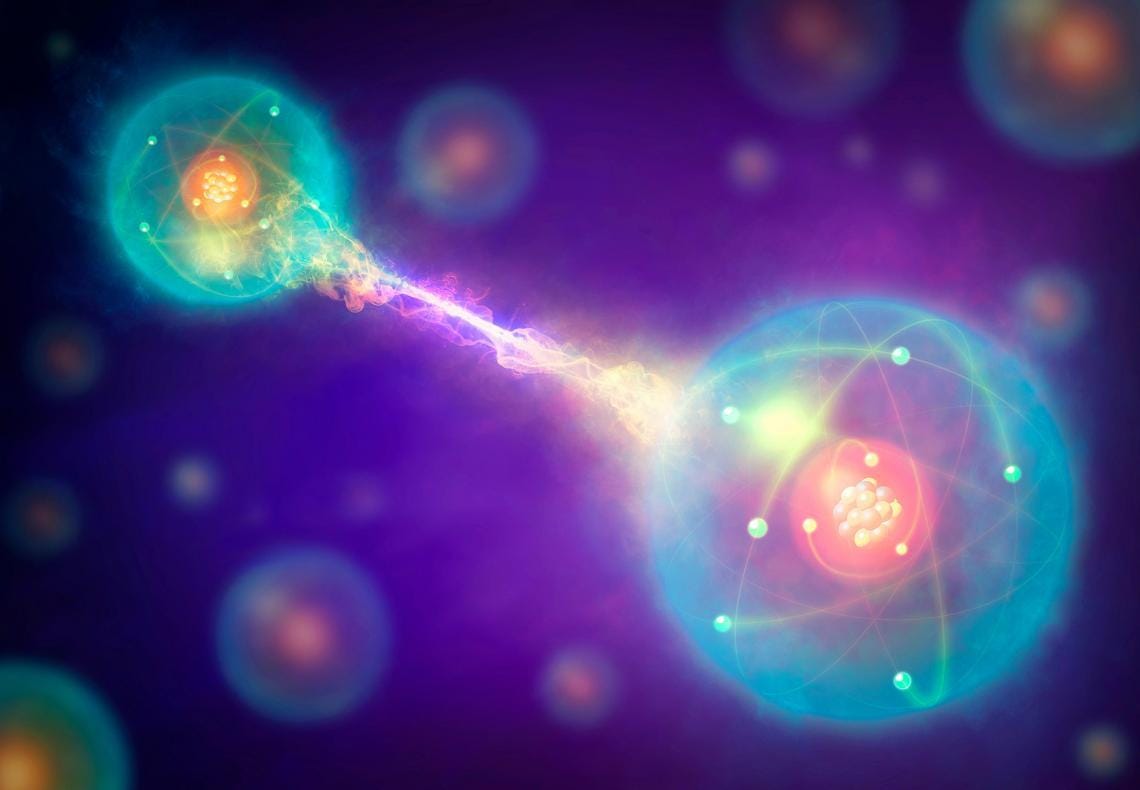The Quantum Leap
October 3, 2023
Welcome to the next installment of the “Quantum Leap Beginner Guides”, aimed at audiences without physics training and using only the most basic math (and even then, only when necessary). So far in this series we have reviewed the general concept of Quantum Mechanics, how quantum mechanics are leveraged via Qubits to take advantage of Wave-Particle Duality and Superposition. I hope these earlier guides enabled readers to get a general sense of how we are now using some of the features of quantum mechanics to perform tasks and calculations never before possible. This introductory series now turns to Entanglement, which is a profound quantum property that may be the most difficult for a lay person to fully understand yet provides some of the most powerful aspects of quantum science.
Regular readers may have noticed a gap since the prior post, which is largely due to the difficulty in explaining Entanglement. In fact, even Einstein struggled with it and referred to it as “spooky action at a distance.” Entanglement is a special kind of superposition. It generally denotes an intrinsic connection between two (or more) quantum particles which provides correlation that can then be exploited. When particles are entangled, we can measure the properties of all the entangled particles by observing just one.
Einstein and his contemporaries such as Boris Podolsky, Nathan Rosen and Erwin Schrodinger were troubled by entanglement in the 1930’s and it wasn’t until 1964 when John Stewart Bell created a theorem that proved entanglement was real. However, that theorem couldn’t be tested until the 1970’s and 1980’s via experiments with entangled photons performed independently by John Clauser, Alain Aspect and Anton Zeilinger, which led to their 2022 Nobel Prize in physics.
The profoundness comes from the fact that two entangled particles retain their connection/correlation despite how far apart you move them, even if they are light years apart! So please suspend any need to “understand” entanglement. Instead, just know that if particles are entangled, they can be used simultaneously which increases the overall power of the system and which enables us to do some amazing things.
Entanglement Drives Exponential Scaling in Quantum Computers
Once you can appreciate that quantum objects, such as qubits, can be entangled, the power that this can provide for computational purposes is fairly straightforward. Since I promised only basic math, here is how this manifests: The number of classical computing bits required to match the computing power of entangled qubits is as follows:
n qubits = 2n bits
So, 3 qubits contain the same computational power as 8 classical bits (i.e., 23) and 13 qubits contain the same computation power as 8,192 bits (i.e., 213) which is equivalent to 1KB of classical computing memory. This exponential scaling gets quite powerful as the numbers of qubits increases, and if we insert a rate of computing processing, we can create a table that showcases the speedup/power that entanglement can provide for quantum computing (paradoxically, it is not just this “speedup” that drives the current interest in Quantum Computing, it is the overall computing power it delivers). Your current personal computer likely processes data at around 4 GHz (meaning 4 billion cycles per second) which is phenomenally fast. Now let’s use that computational speed to see how entanglement can power quantum computers, which is depicted in the table below:
As the table above shows, 40 qubits1 has the same computation power as 1.1 trillion bits, although with 4GHz processing speed, classical computers can still evaluate that in a few minutes. However, as we scale to 100 qubits, the potential power of quantum computers can be appreciated given that that would be the equivalent of an Exabyte (1 billion GB) of classical computing power, which at 4GHz would take more time to compute than the age of the universe!
So, the bottom line is that a quantum computer with 100 perfect qubits with all-to-all connectivity (full entanglement), could execute computations that can never be practically replicated with classical computing resources. Naturally there are many caveats: we don’t need that kind of power for most current computing applications, qubits today are still very noisy and lose their information rapidly, and entangling many qubits simultaneously is quite challenging. However, progress is advancing swiftly.
Entanglement Enables Ultra-Precise Sensors
One of the main challenges in scaling Quantum Computers is the fragility of qubits, and their tendency to decohere rapidly due to various external stimuli (i.e., changing magnetic and electric fields, heat, vibrations, and even cosmic rays). However, this challenge is actually a powerful enabling feature of quantum sensors. While Quantum Computing captures most of the press headlines despite relatively modest existing machines, other quantum applications are already being deployed and quantum sensing is a large, existing and growing field.
“Sensing” generally refers to measuring some sort of system change. A sound sensor measures the change in movement a sound causes to a diaphragm and a gravitometer measures the differences in gravitational pull among differing masses. By exploiting entanglement, scientists are improving measurement sensitivity as well as the speed of measurement. Because the fluctuations in two entangled sensors are linked, the uncertainties in their phase measurements are correlated. Layering in certain mathematics, a team at the University of Michigan recently proved that they could use quantum sensors to improve sensitivity by 40% and that they could perform the measurements 60% faster.
The enhanced accuracy and precision that entanglement brings to quantum sensors is beginning to apply to a wide variety of measurements including time, frequency, acceleration, temperature, pressure, rotation, gravity, magnetic and electric fields. This will have a transformative impact in areas including defense, health care, electronics, geology, energy and aerospace, among others.
Summary
It is difficult for humans to grasp and fully understand quantum effects given that they occur on a scale we are not generally familiar with, and result in properties that don’t have a good equivalent in our human body-sized scale. Entanglement is a prime example of that. However, scientists are able to create and measure entanglement and use it to power a new form of computing as well as create ultra-precise and ultra-accurate sensors.
Stay tuned to the Quantum Leap to learn more.
References:
Entanglement Image credit: Mark Garlick/Science Photo Library via Getty Images.
Bird Swarm/Murmuration credit: Dylan Winter via globalstewards.org
Bobier, Langione, Naudet-Baulieu, Tamme and Gourevitch, “Making Sense of Quantum Sensing,” BCG.com, July 17, 2023.
Emspak, Jesse and Hickok, Kimberly, “What is quantum entanglement?” Space.com, March 16, 2022.
Gupta, Harshit, “On Quantum Entanglement,” as published on Medium.com, January 13, 2023.
Hesla, Leah, “The Entanglement Advantage,” Argonne National Laboratory, November 28, 2022.
Siegel, Ethan, “Quantum entanglement wins 2022’s Nobel Prize in physics,” Medium.com, October 12, 2022.
“New analysis paves way for more sensitive quantum sensors,” News.uchicago.edu, November 16, 2020.
“Quantum entanglement,” Wikipedia.org, accessed August 21, 2023.
“Quantum entanglement could make accelerometers and dark matter sensors more accurate,” news.umich.edu, accessed September 1, 2023.
“What Is Entanglement and Why Is It Important?” Scienceexchange.caltech.edu, accessed August 21, 2023.
If you enjoyed this post, please visit my website and enter your email to receive future posts and updates: http://quantumleap.blog
Russ Fein is a venture investor with deep interests in Quantum Computing (QC). For more of his thoughts about QC please visit the link to the left. For more information about his firm, please visit Corporate Fuel. Russ can be reached at russ@quantumleap.blog.
For now, these are theoretical figures which assume all-to-all connectivity of perfect qubits. Today, there are various challenges to such connectivity, and most qubits are still proving difficult to control for extended periods of time (i.e., long enough to complete the computations), but advances are happening rapidly.








